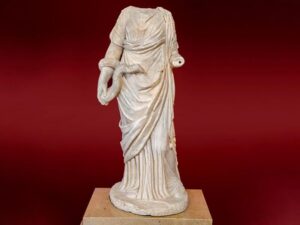
Turkish Archaeologists Unearth Headless Statue of Greek Health Goddess

Excavations in western Turkey have revealed a marble statue depicting Hygieia, the Greco-Roman goddess of health and cleanliness.
As Muharrem Cin reports for the state-run Anadolu Agency (AA), experts unearthed the life-size sculpture during digs in the ancient city of Aizanoi, located in the Çavdarhisar district of the country’s Kütahya province.
Aizanoi also houses one of the most well-preserved temples in Anatolia devoted to Zeus, the thunderbolt-carrying Greek Olympian. This second century B.C.E. structure features several Doric columns and a central space known as an agora, which is where archaeologists uncovered the recently discovered statue, writes Maria Gabrielle for National Geographic Indonesia.
Speaking with AA, dig leader Gökhan Coşkun of Turkey’s Kütahya Dumlupınar University says, “We’re trying to reveal the columned galleries on the west and south wings of the agora (bazaar) and the shops right behind them.”
Experts have been excavating Aizanoi which was added to the UNESCO World Heritage Tentative List in 2012 for almost a decade. Per AA, a team of 100 workers and 25 technicians in the region aided this summer’s dig.
The effigy depicts a woman wearing elegant, draped clothing, but her head is missing.
“Unfortunately, it hasn’t survived to the present day, but in its current form, we can see that this statue is about the size of a human,” Coşkun tells AA.
Per Mark Beumer of World History Encyclopedia, early civilizations usually relied on rituals and herbs to cure sick people, but they also turned to deities to safeguard their health. Ancient Greeks often worshipped Hygieia alongside the medicinal god Asclepius, and a healing cult dedicated to them existed in Athens from around 500 B.C.E. until 500 C.E. After a plague broke out in Greece during the fifth century B.C.E., the cult spread, eventually reaching Rome in the second century C.E., according to Science Museum Group.
Hygieia’s devotees erected statues to the goddess in the temples of Asclepius, some of which were located in Epidaurus, Corinth, Cos, and Pergamon. Per the Science Museum Group, these sculptures often showed her holding or feeding a large snake, which was the symbol of Greek medicine.
Aspects of Greco-Roman culture spread to Aizanoi when the Roman Empire took control of the region in 133 B.C.E., according to the Turkish Ministry of Culture and Tourism. During Roman rule, the city’s population swelled to between 80,000 and 100,000 people, and locals often frequented various attractions around it, including the Temple of Zeus, an amphitheater that held up to 15,000 people, a theater, and a mosaic bathhouse, per AA.
Per the Turkish Ministry of Culture and Tourism, the metropolis reached its heyday between the second and third centuries C.E. and became “the center of the episcopacy in the Byzantine era.”
Between 1970 and 2011, the German Archeology Institute excavated a number of structures in Aizanoi, including a theater, a stadium, a gymnasium, five bridges, and the sacred cave of Metre Steune, a religious site dating to before the first century B.C.E.
In addition to these discoveries, experts have also uncovered other statues of Hygieia in the region.
“During past digs in Aizanoi, finds related to Hygieia were also found,” Coşkun tells AA. “This situation makes us think that there may have been some construction and buildings related to the health cult in Aizanoi during the Roman era.”
In 2017, a separate team of archaeologists also unearthed a headless, two-piece effigy of the goddess in Turkey’s southern province of Adana. The nearly 5.7-foot-long limestone figure, which dates to the third or fourth century B.C.E., revealed that the area’s previous inhabitants valued medicine and pharmacology, reported the Hurriyet Daily News in 2017.
smithsonianmag.com/


